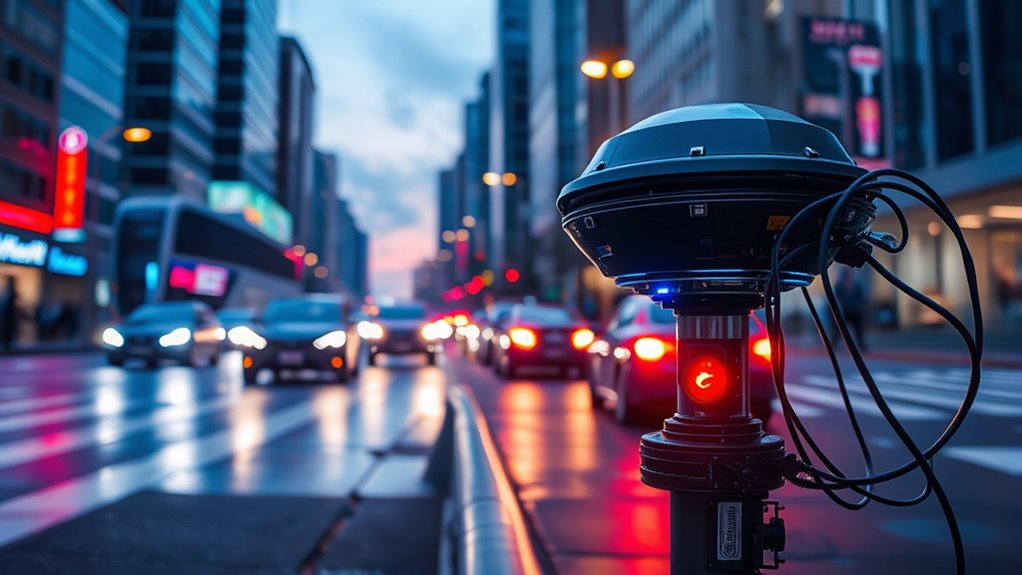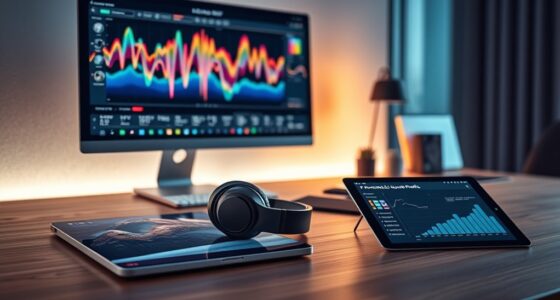AI-driven vibration sensors can transform traffic sounds and motions into real-time alerts, helping your city detect congestion, accidents, and unusual traffic patterns quickly. These sensors pick up subtle vibrations caused by vehicles and convert them into digital data, which advanced AI analyzes to identify issues. With this technology, city managers can respond faster and improve safety. If you want to learn more about how this smart sensing system works and its impact, keep exploring further.
Key Takeaways
- AI analyzes vibration data from sensors to accurately detect traffic flow and disturbances in real-time.
- Vibration sensors convert sound and movement into digital signals for precise traffic monitoring.
- Advanced AI algorithms identify anomalies like accidents or congestion from urban vibration patterns.
- Real-time alerts enable rapid response to traffic issues, improving safety and urban efficiency.
- Continuous calibration and privacy safeguards ensure reliable, secure, and trustworthy city sensing systems.
The Shift Toward Smarter Urban Environments
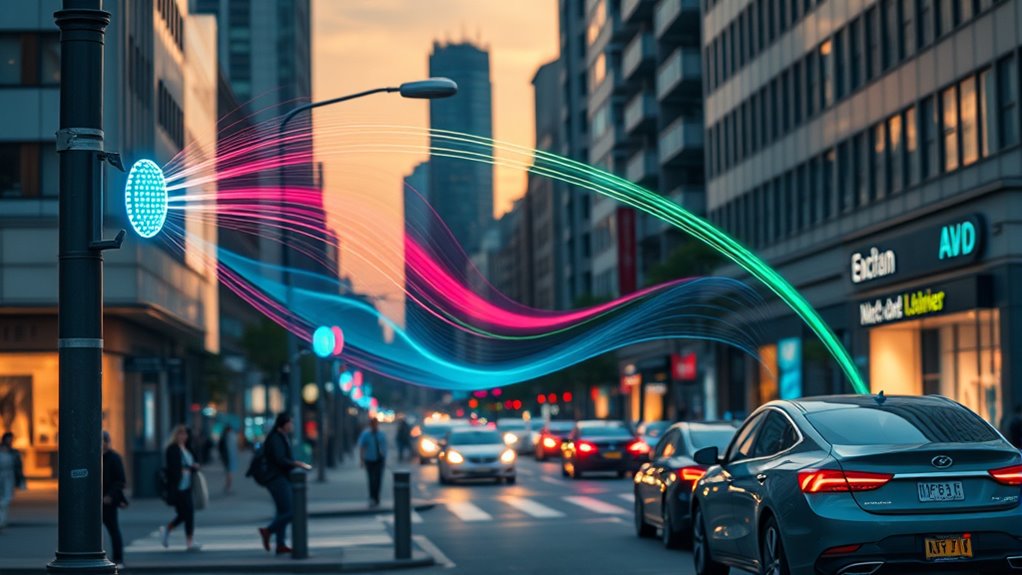
As cities grow more complex, there’s a clear move toward smarter urban environments that leverage technology to improve daily life. You’ll notice efforts to manage urban noise, which can disrupt residents and hinder communication. By monitoring noise levels, cities can identify problem areas and implement targeted solutions, creating a more pleasant environment. Additionally, understanding pedestrian flow becomes essential as populations increase. Smart sensors track movement patterns, helping planners optimize crosswalks, signals, and public spaces. This data-driven approach makes urban areas more efficient and safer. Incorporating home furnishings that are designed with smart technology can further enhance comfort and safety in these environments. As a result, you experience less congestion, quieter streets, and smoother pedestrian experiences. These innovations demonstrate how integrating technology into city infrastructure can enhance your daily routines and make urban living more sustainable.
How Vibration Sensors Capture Traffic Dynamics

Vibration sensors play a crucial role in capturing traffic dynamics by detecting the subtle movements caused by passing vehicles. To guarantee accurate readings, regular sensor calibration is essential, aligning the sensor’s sensitivity with traffic patterns and environmental conditions. Proper calibration minimizes errors and improves data reliability. As these sensors collect detailed traffic movement data, data privacy becomes a key concern; measures like anonymization and secure storage protect user information. Vibration sensors detect vibrations transmitted through surfaces, translating physical movements into digital signals that reveal traffic flow, congestion, and vehicle types. This process benefits from an understanding of positive thinking strategies, which can aid city officials in maintaining a proactive and solutions-oriented approach when addressing data challenges. This real-time data helps city managers optimize traffic signals and improve urban mobility, all while maintaining privacy standards. Accurate calibration and privacy safeguards ensure the sensors deliver trustworthy insights that enhance city infrastructure without compromising individual rights.
Transforming Sound and Motion Into Data
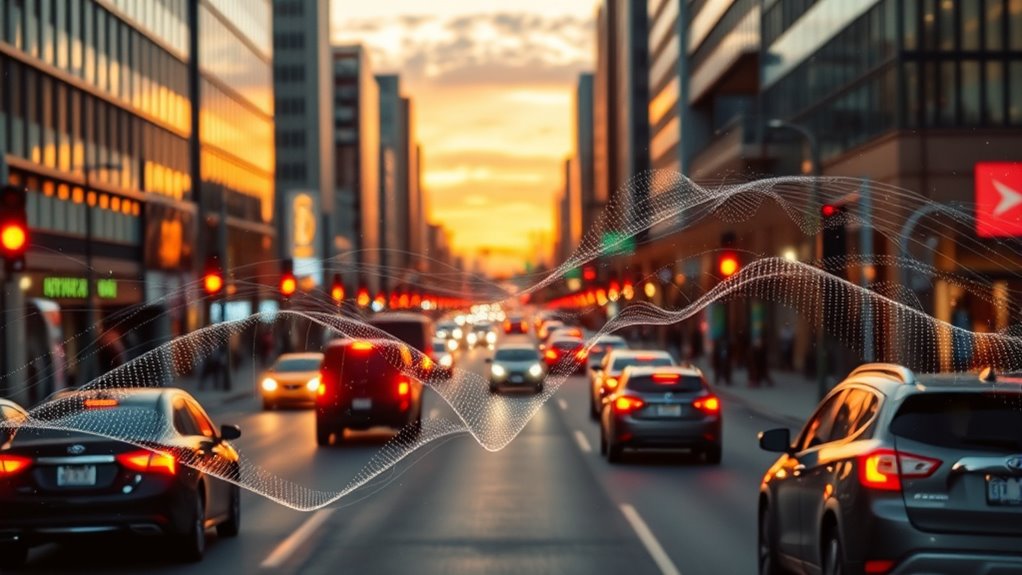
Transforming the physical signals captured by vibration sensors into usable data involves sophisticated processing techniques. Urban noise, such as honking or engine sounds, can interfere with accurate readings, making sensor calibration essential. Proper calibration guarantees sensors distinguish between relevant traffic vibrations and background noise, improving data quality. You’ll process raw signals through filtering algorithms to reduce noise and amplify meaningful patterns. These processed signals are then translated into digital data points that represent sound intensity, vibration frequency, and motion patterns. This transformation allows you to analyze traffic flow, detect anomalies, and identify specific events like accidents or congestion. By refining this conversion process, you turn complex, real-world vibrations into precise, actionable information for smart city traffic management. Calibration accuracy is crucial to ensure the reliability of the data collected.
The Role of Artificial Intelligence in Analyzing Vibrations

Artificial intelligence plays a crucial role in analyzing vibration data by automatically identifying patterns and anomalies that would be difficult for humans to detect manually. It processes signals from sensors, ensuring accurate readings through sensor calibration. AI models use noise filtering techniques to eliminate irrelevant data, enhancing detection accuracy. Here are key ways AI contributes:
- Detects subtle vibrations indicating potential issues
- Differentiates between normal traffic sounds and unusual events
- Continuously learns and improves detection through machine learning
- Automates data analysis, reducing human oversight and response time
Detecting Congestion and Accidents in Real Time
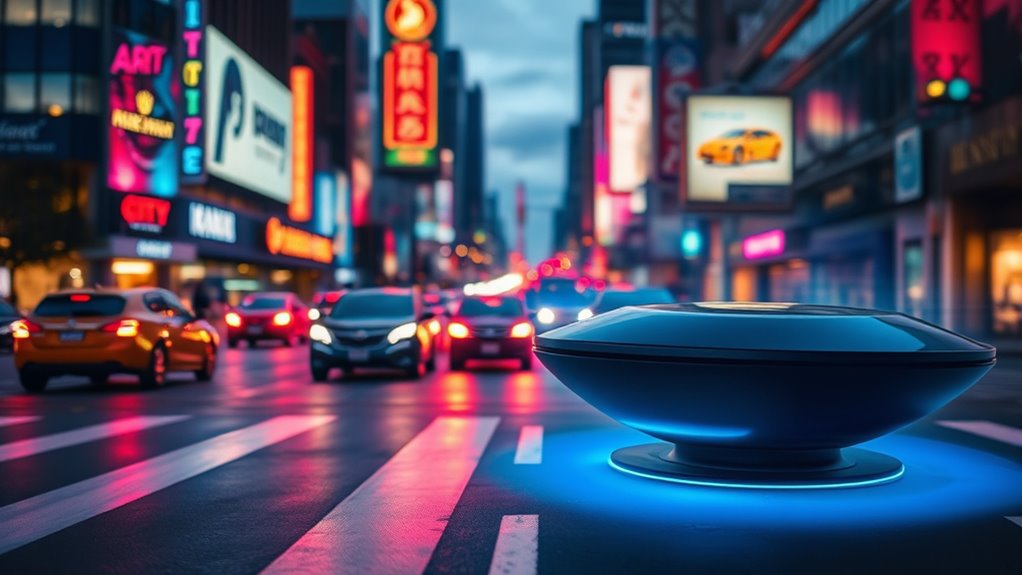
Real-time detection of congestion and accidents is essential for maintaining smooth traffic flow and enhancing safety. By analyzing urban noise patterns and vibration data, AI can identify sudden changes indicating a traffic jam or collision. Elevated noise levels often signal congestion, while irregular vibrations may reveal accidents or stalled vehicles. Monitoring pedestrian flow helps determine if crowding or unexpected stoppages are contributing to delays or hazards. This rapid detection allows traffic management systems to send alerts promptly, reroute vehicles, or dispatch emergency services. Your sensors continuously analyze vibration and sound data, providing a live picture of traffic conditions. This approach minimizes delays, prevents secondary accidents, and keeps traffic moving efficiently, all by turning traffic sounds and vibrations into actionable insights in real time. Incorporating advanced sensor technology enhances the accuracy and reliability of these detections, ensuring timely responses.
Benefits of Vibration-Based Traffic Monitoring
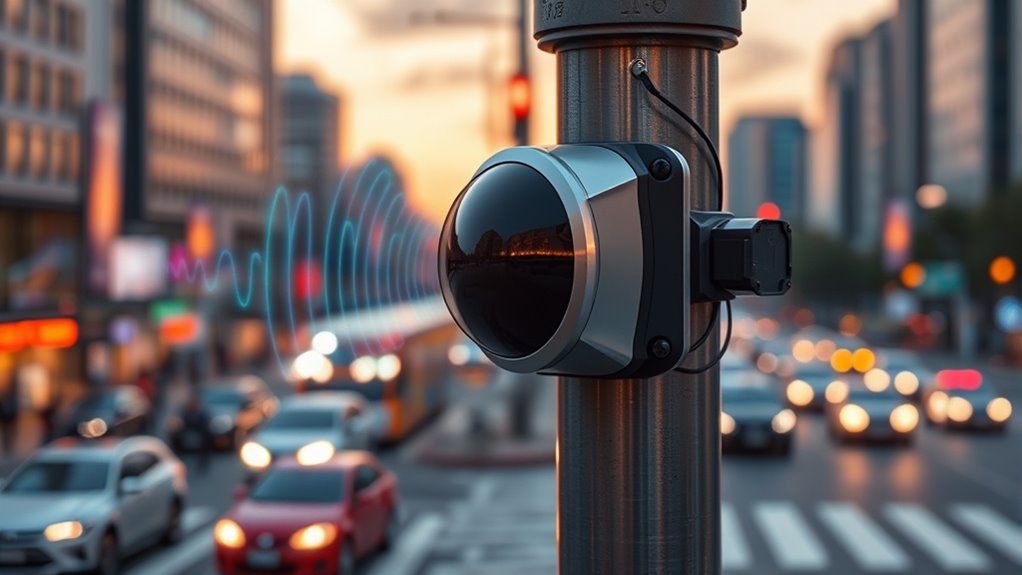
Vibration-based traffic monitoring offers several key benefits that enhance urban traffic management. First, it reduces traffic noise by detecting vibrations instead of relying solely on sound, creating less disturbance in neighborhoods. Second, it provides real-time data on pedestrian flow, helping optimize crossings and improve safety. Third, this technology allows for continuous, non-intrusive monitoring of traffic patterns without adding infrastructure clutter. Fourth, it helps identify congestion hotspots early, enabling quicker responses and smoother traffic flow. By focusing on vibrations, you get a clearer picture of traffic dynamics and pedestrian activity, leading to smarter traffic control strategies. Additionally, understanding sensor technology advancements can further improve detection accuracy and system reliability. Overall, vibration-based monitoring enhances city responsiveness, improves safety, and reduces noise pollution, making urban environments more livable and efficient.
Challenges and Limitations of the Technology
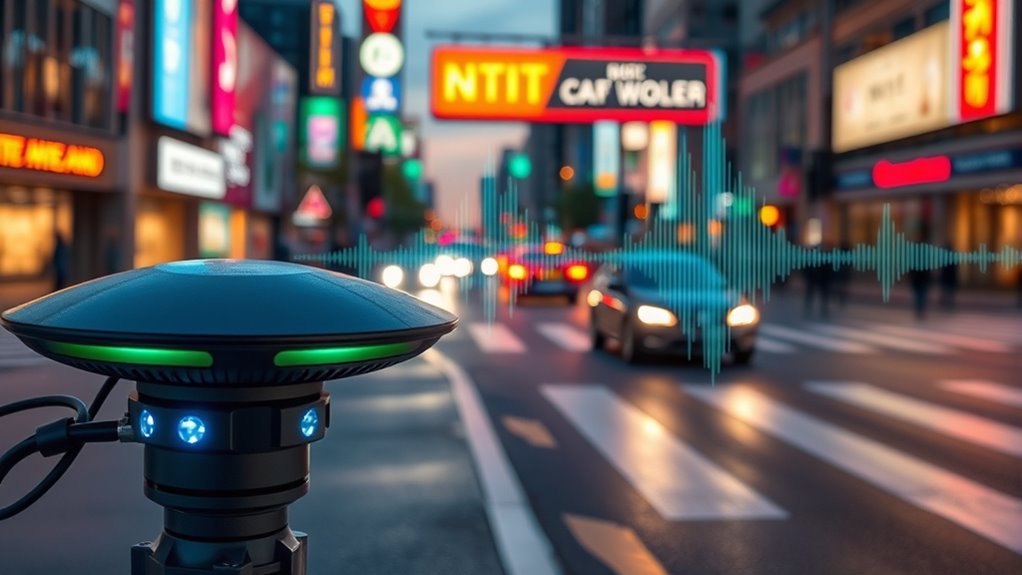
While vibration-based traffic monitoring offers notable advantages, it also faces several challenges that can limit its effectiveness. Privacy concerns arise because sensitive data about city activities could be inadvertently collected or misused. Ensuring data security and transparency is essential to gain public trust. Additionally, sensor reliability remains a significant hurdle; vibrations from non-traffic sources like construction or weather can cause false alarms or obscure traffic signals. Environmental factors, such as dirt or weather conditions, can also degrade sensor performance over time. These limitations mean you need robust calibration and maintenance to keep the system accurate. Without addressing privacy issues and ensuring sensor durability, the technology’s potential to improve traffic management remains constrained. Moreover, community engagement plays a crucial role in addressing public concerns and fostering acceptance of new monitoring systems.
Integrating Vibration Sensors With City Infrastructure
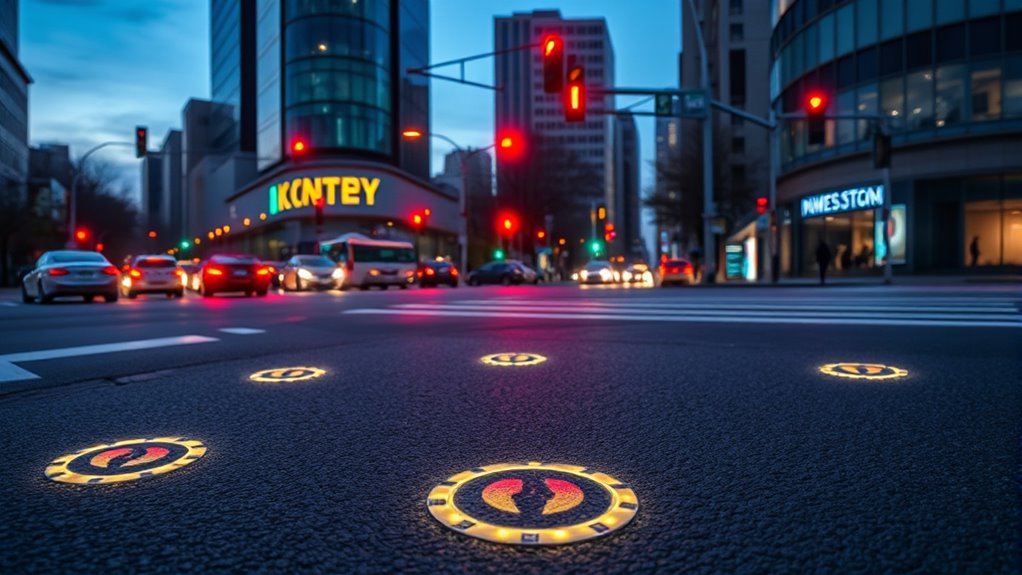
Integrating vibration sensors into city infrastructure requires careful planning to guarantee seamless operation within existing systems. To do this effectively, you should consider:
- Evaluating urban noise levels to distinguish traffic vibrations from background sounds.
- Selecting vibration sensors with adequate sensitivity for detecting traffic-induced vibrations.
- Implementing vibration mitigation strategies to reduce false alarms caused by unrelated vibrations.
- Ensuring compatibility with current infrastructure, like bridges and pavements, for reliable readings.
- Prioritizing Vibration Detection accuracy by calibrating sensors to adapt to specific urban environments.
Future Prospects for AI-Driven Urban Sensing
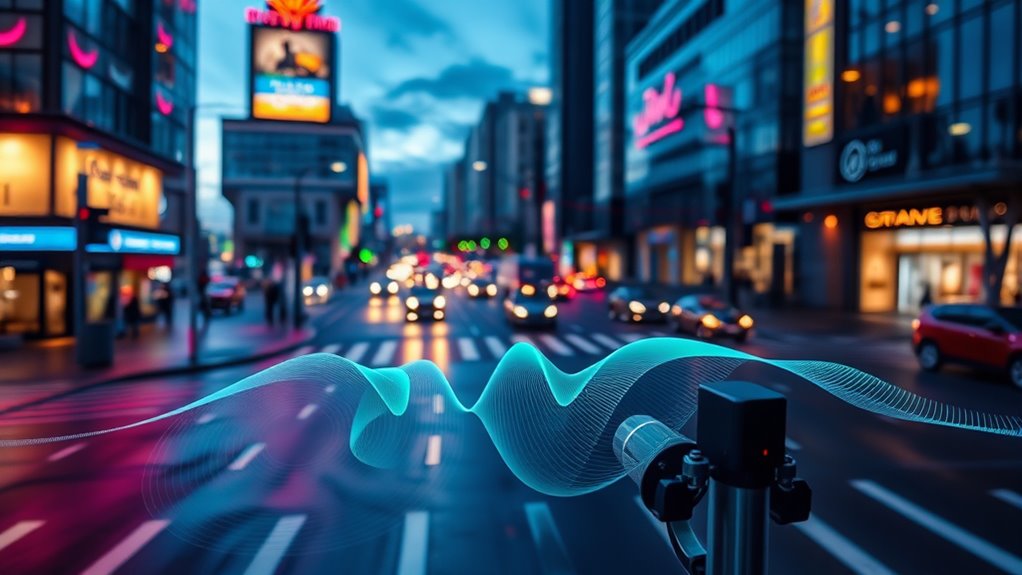
Future urban sensing will substantially improve how you monitor traffic and environmental conditions. AI will enable seamless integration with smart infrastructure, making systems more responsive and efficient. This progress will help create safer, more connected cities for everyone. As AI technology continues to advance, addressing AI security vulnerabilities will be crucial to ensuring reliable and safe deployment of urban sensing systems.
Enhanced Monitoring Capabilities
AI-driven urban sensing is set to revolutionize traffic monitoring by offering real-time, highly accurate data collection. With advanced sensor calibration, your systems will quickly adapt to environmental changes, ensuring consistent data quality. Enhanced monitoring capabilities include:
- Improved sensor calibration to maintain accuracy over time.
- Better detection of traffic anomalies and patterns.
- Real-time alerts for unusual noise or vibrations.
- Strengthened data privacy measures to protect user information.
- Incorporating user consent management ensures that data collection aligns with privacy policies and regulatory standards.
These improvements allow you to monitor the city more effectively, responding swiftly to traffic issues. As sensors become more precise and secure, your infrastructure benefits from trustworthy insights. Enhanced monitoring not only boosts traffic flow but also builds public trust by prioritizing data privacy and system reliability.
Integration With Smart Infrastructure
Building on the enhanced monitoring capabilities, smart infrastructure can leverage these precise, real-time data streams to optimize urban systems. By integrating AI-driven vibration and sound sensors, cities can better address noise pollution, creating quieter, healthier environments. These systems can detect high noise levels near busy roads or construction zones, enabling rapid responses to reduce disturbances. Additionally, real-time alerts improve pedestrian safety by signaling unsafe traffic conditions or excessive noise that might distract drivers and pedestrians alike. Connecting these sensors to traffic lights, public alerts, and navigation apps ensures swift, coordinated actions. As a result, urban spaces become safer and more livable, with smarter management of noise pollution and enhanced awareness of pedestrian safety, paving the way for truly intelligent city infrastructure. Incorporating real-time data analysis can further enhance the responsiveness and effectiveness of these systems, leading to more adaptive and resilient urban environments.
Impact on City Planning and Public Safety
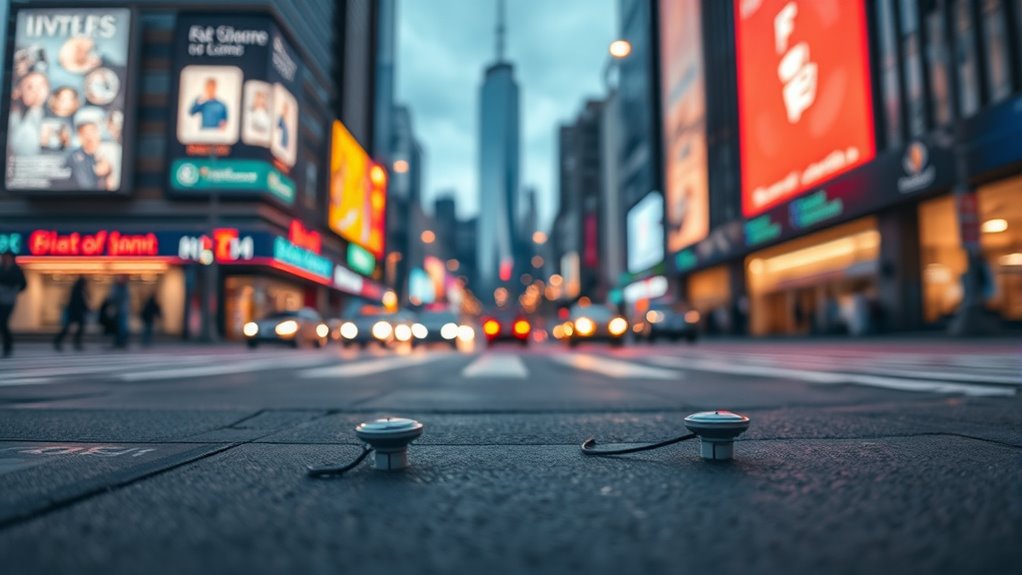
The integration of traffic sound alerts into city planning considerably enhances public safety and infrastructure efficiency. By analyzing urban noise and pedestrian flow, you can better address congestion and safety concerns. Here’s how it impacts you:
- You can identify high-traffic zones, reducing urban noise and improving living conditions.
- You gain real-time insights to optimize pedestrian pathways, making crossings safer.
- You can deploy targeted interventions where vehicle and foot traffic intersect, preventing accidents.
- You improve emergency response by quickly detecting unusual traffic patterns or disruptions.
Frequently Asked Questions
How Do Vibration Sensors Differentiate Between Traffic Noise and Other City Sounds?
You might wonder how vibration sensors distinguish traffic noise from other city sounds. They analyze sound frequency patterns, focusing on specific vibrations typical of vehicles. Through sensor calibration, they fine-tune sensitivity levels to target these vibrations accurately. By filtering out irrelevant sounds and honing in on unique traffic frequencies, the sensors effectively differentiate between traffic noise and other urban sounds, ensuring precise alerts for city management.
What Privacy Concerns Arise With Vibration-Based Urban Sensing Technologies?
You should consider that vibration-based urban sensing raises privacy concerns because data privacy might be compromised if sensitive information is captured inadvertently. Additionally, if sensor security isn’t robust, malicious actors could hack into the system, manipulate data, or cause disruptions. Protecting user privacy and ensuring sensor security are vital to prevent misuse, maintain trust, and responsibly deploy these innovative technologies in city environments.
How Cost-Effective Is Implementing Vibration Sensors Across Entire Cities?
You might wonder how cost-effective it is to implement vibration sensors across entire cities. A thorough cost analysis shows initial setup costs can be high due to infrastructure challenges like installing sensors on widespread roads and ensuring reliable power. However, over time, these sensors can save money by providing real-time traffic data, reducing congestion, and improving urban planning. Balancing upfront expenses with long-term benefits is key to evaluating overall cost-effectiveness.
Can Vibration Sensors Predict Traffic Patterns Before Congestion Occurs?
Sure, your urban noise-loving sensors might seem psychic, but predicting traffic patterns before congestion? That’s ambitious. Vibration sensors, when properly calibrated, can detect subtle shifts indicating upcoming jams. However, they’re not fortune-tellers. You’ll need precise calibration and integration with other data. While they improve real-time alerts and help manage congestion, full prediction still requires a mix of advanced AI and, perhaps, a little city magic.
What Maintenance Is Required to Keep Vibration Sensors Functional Over Time?
To keep vibration sensors functional over time, you need to regularly perform sensor calibration to guarantee accuracy. Additionally, focus on effective power management by checking batteries or power sources and optimizing energy use. Clean sensors to prevent debris buildup that can affect readings. Regular maintenance like these helps maintain sensor reliability, so your traffic monitoring system continues to operate smoothly and provides accurate alerts for congestion or other issues.
Conclusion
By embracing AI-driven vibration sensors, you can transform traffic sounds into real-time alerts, boosting safety and efficiency. Did you know that cities using such technology have reduced congestion by up to 20%? As you integrate these sensors into urban infrastructure, you’ll enhance city planning and respond faster to accidents. This innovative approach not only makes your city smarter but also safer, paving the way for a more connected, responsive urban future.

